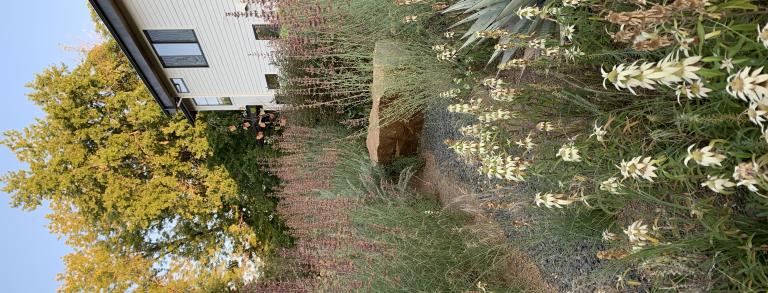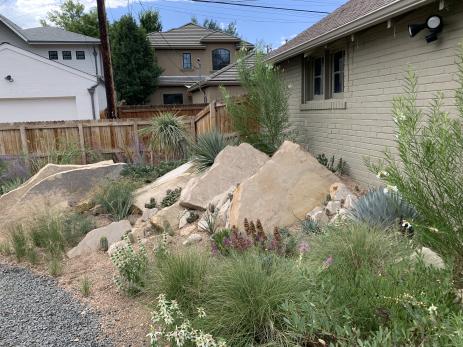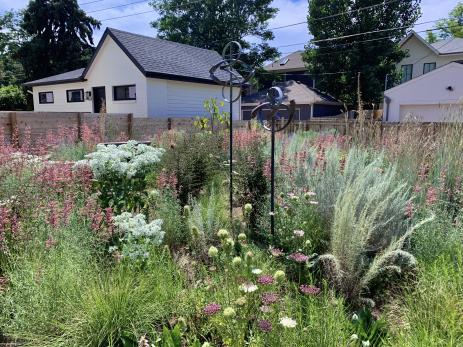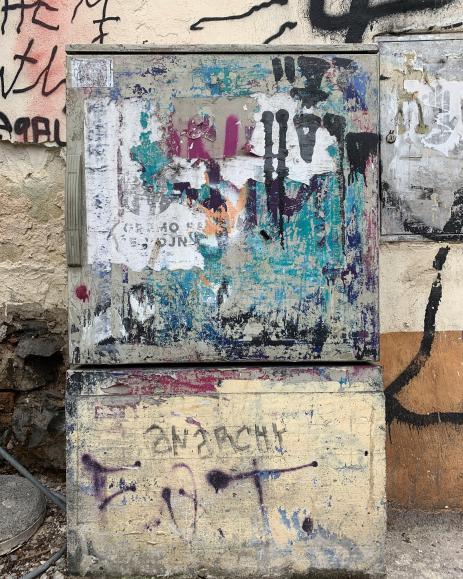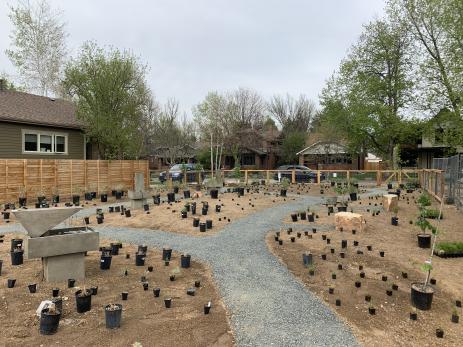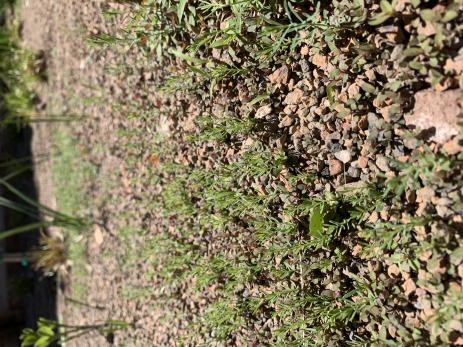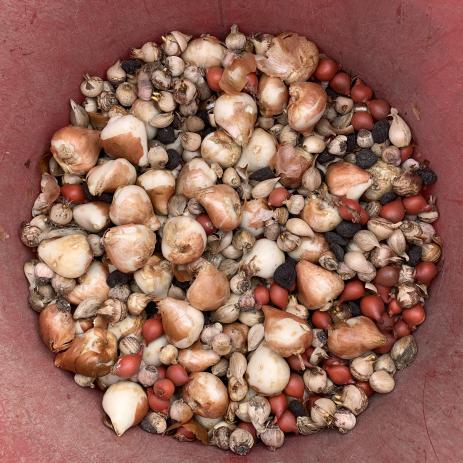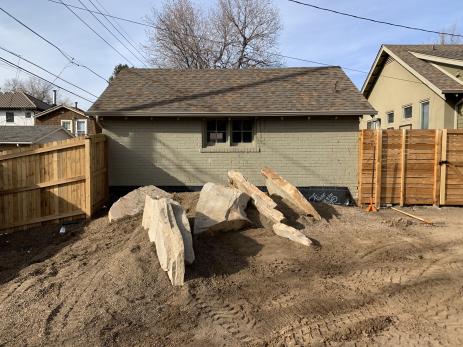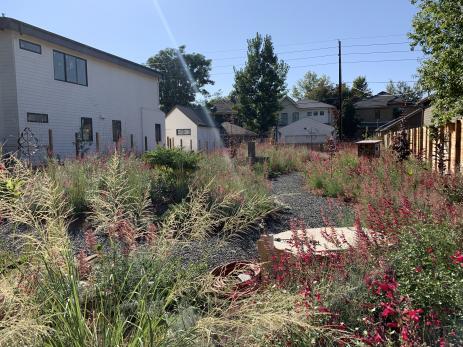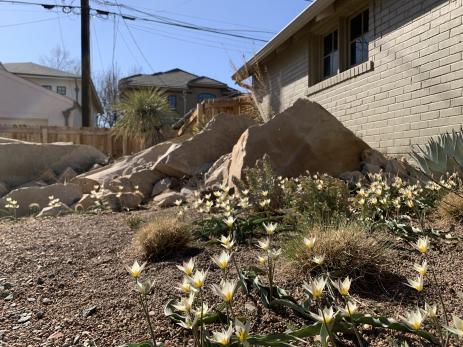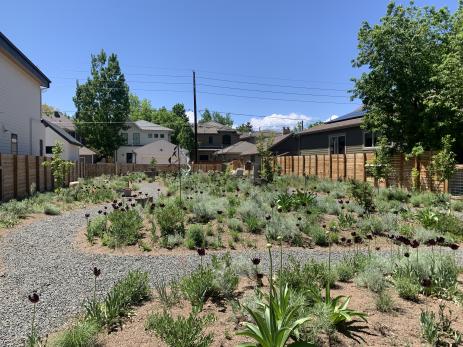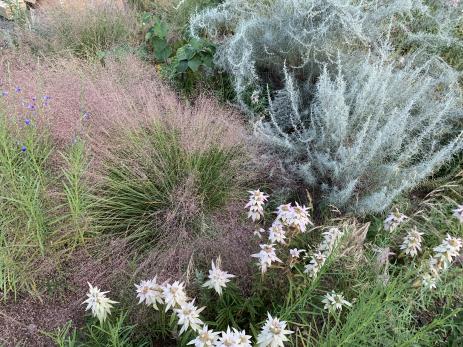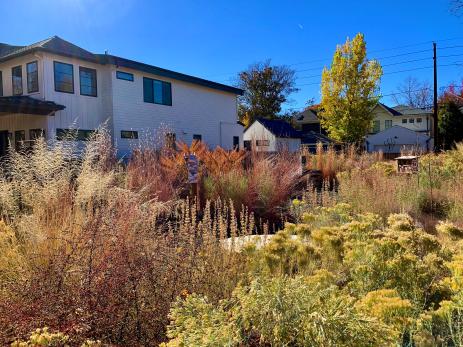IN MARCH OF 2020, I was setting stones just as the COVID-19 shelter-in-place orders were coming down across Denver. Although I jumped a bit as the cell phone emergency alert was pushed through, it wasn’t unexpected. The city had felt emptier and more tentative for weeks. Before this time, moments of quiet and isolation in the city were few and far between. Crouching in the corner of the empty lot, surrounded by rubble, trying to put the pieces together and build something new felt post-apocalyptic. I didn’t know the coming waves that would transmute the world over the course of the ongoing pandemic, but I felt strongly that a movement was forming on this singular city plot. The desolation spoke to me: Drought tolerant is dead. The future is drought dynamic.
The vision for SummerHome Garden was pioneered by Lisa Negri, a community leader in the Washington Park neighborhood of Denver, Colorado, and a lifelong resident of the city. Lisa had become weary of the development trends that obliterated modest homes with ample front and backyards and replaced them with mini-mansions that devoured the square footage from edge to edge. Resistant to the idea of her home being boxed in by a three-story build and wishing to add to the common greenspace of the city, Lisa bought the uninhabitable home next to hers and knocked it to the ground, collapsing it into its basement and creating a new pocket park for Denver.
Lisa wanted to create a safe, inspirational, and horticulturally progressive space for the community to enjoy. SummerHome would challenge the stilted design and regionally inappropriate gardens still found throughout the city, especially accompanying new builds.
SummerHome would not be on life support, rather it would support life and serve as a new guidepost for the potential of naturalistic, xeric design in the semi-arid West. Through a partnership with Denver Botanic Gardens that Lisa had cultivated through her philanthropic efforts, and a personal relationship that she and I formed through her years of volunteer work, I was tapped to design, implement and steward the development of SummerHome.
My interest in shrub-steppe ecosystems combined with Lisa’s love of the xeric plants of the southwest and general inclination for Western American aesthetics steered the design. We decided early on that all species used would be commercially available. If this was to be a truly instructional space, we needed to include plants that anyone could access. That qualifier would allow us to conceptualize new contexts for some plants perceived as pedestrian or overused. I enthusiastically incorporated Salvia yangii (previously known as Perovskia atriplicifolia) into the garden knowing that it was easily available and ripe for a more advanced design treatment.
Drought dynamic was a guiding concept of the design. Tolerance conveys endurance, suffering, and rigidity against shifting elements to maintain a static state. Dynamism is about adaptability. I was interested in a multi-pronged approach to produce a garden that would be responsive to its environment and offer an ever-evolving display over time.
The garden was open to all possibilities, a blank slate, literally razed earth. Apart from design considerations to maximize viewsheds, visitor privacy, and access points, Lisa had only one request: a rock garden to grow and display cacti and other succulents. We utilized the hottest, driest corner of the lot and a wall of brick from Lisa’s adjoining garage as a further heat sink to both contain and nurture the succulents. The structure for the xeric crevice garden sits at the intersection of the lithe and the horrific. It’s a metacarpal arachnid, posing and striking from the corner. A monster, full of spines, glochids, and fleshy protuberances hid in the thicket. With this guiding nightmare, we nestled several tons of Colorado buff sandstone into a fast-draining mixture of sand, expanded shale, and screened compost to create a heavily ridged uplift. This feature now contains dozens of selections of cacti and succulents as well as xeric shrubs like Salvia pachyphylla, Chilopsis linearis, and Lycium pallidum.
I generated preliminary plant lists based on the successes of some of my previous installations and ideated more with Lisa based on her botanical desires. The palette coalesced around stress-tolerant and ruderal species, heavy in shrubs, self-seeding perennials and annuals, and charismatic bunch grasses. Shifting away from mixed-grass prairie motifs, we embraced the shrubby and made Ericameria nauseosa, Artemisia filifolia, Atriplex canescens, Fallugia paradoxa, and Krascheninnikovia lanata the stars.
Sometimes the curse of the garden is the gardener, and almost always the curse of the design is the designer. In the song “Cruelty Abounds” Spencer Moody yelps, “Does the singer wanna wreck the song? I do not know, but surely sometimes that’s just how it sounds.” To dissolve contrivances and avoid any sense of heavy-handedness or overt intentionality in designing SummerHome Garden, I created a tool for naturalistic design called Wild Systems Emulation.
Wild Systems Emulation seeks visual examples of surprising actions within a system as the jumping-off point for the arrangement of a design. They can be the result of intentional or unintentional forces and from either anthropogenic or non-anthropogenic sources. Using these snapshots of constantly changing systems to guide the placement of plants, plant communities, architectural, and hardscape elements has the short-term effect of creating a garden that feels as if it is already in motion and the long-term effect of encouraging a competitive, evolving garden. Using these wild, open-source examples of composition and expression as jumping-off points for planting helps to alleviate the heavy-handedness of the designer and encourage acceptance of wandering and competing plant communities.
The layout of SummerHome Garden was modeled on graffiti captured on a public utility box in Ljubljana, Slovenia. This radical object had been spray-painted, stickered, markered, wheat-pasted, sat upon, scraped, and battered by the elements for years. The result was an urban collage that no singular being, person, or force could have planned. However, despite the seeming chaos, patterns, dots, speckles, drifts, spatters, emotive lines, and harmonious colors emerged. The next step in utilizing Wild Systems Emulation is identifying these dominant and desired elements and applying individuals or groupings of plants to them. In the section of the utility box graffiti-scape that I chose to emulate, I identified ten unique communities to develop. Within each of these areas, a predetermined group of plants was randomly planted, then complimentary species oversown as a seed mixture, creating a thick, vibrant, interstitial layer. I then overlaid a selection of megaflora (graminoids, forbs, and trees) as spatial-visual enhancements.
Additionally, a bulb layer, created by Sonya Anderson, assistant curator of pollinator gardens and Plant Select at Denver Botanic Gardens and a geophyte specialist, was designed to provide flowering during the most botanically inactive months and offer upright props and pops during the early growth phases of the herbaceous plantings.
It was important for us to demonstrate that a successful garden could be created without soil treatments or amendments. Except for the well-draining mix engineered for the xeric crevice garden and some additional soil brought in from adjacent excavation sites in the neighborhood to finish filling the basement of the imploded house, the existing soils of the property were not enhanced. Also, in place of an irrigation system (in the spirit of xeriscaping), four frost-free standpipes were installed on the property, allowing for targeted hand-watering of plants during establishment.
After pathways were carved and small landforms made to define the planting beds, layout and planting were achieved in two sessions, a week apart, in early May of 2020. Bulb planting and overseeding took place in late October, 2020. These were done in concert to take advantage of the disturbance of the expanded shale mulch and topsoil. We sowed about a dozen species of ruderal and stress tolerating forbs to fill the interstitial spaces of the garden including Linum lewisii, Monarda punctata, Ipomopsis rubra, and Eschscholzia californica.
Over the course of 2020, the garden started to pull together, offering varying flowering periods, the promise of structure, and a certain foal-like ranginess that young plants often have. The biggest show came in the first autumn with an unexpected explosion of many of the young Lamiaceae species. Specifically, Windwalker® royal red salvia had a fantastic presence, giving the swelling forms throughout the garden lipstick-red edges. Unfortunately, due to an early freeze and subsequent polar vortex, more than 90% of the Windwalker® royal red salvia population died off. Although many did regenerate the following year, their visual impact was greatly reduced. For the most part, however, we let the garden develop through 2020 without shifting the original palette too much, knowing that it was still young and needed time to begin expressing itself.
2021 brought a radical visual change to SummerHome. Early spring bulbs like Tulipa ‘Black Parrot’, Tulipa turkestanica, and Allium ‘Ambassador’ brought successive crests of color to the slowly awakening beds in large, monochromatic threads that unified the thin, post-winter space. The foliar bump of late May and June created masses of rich greens, blues, and silvers with the emerging warm-season grasses and refoliating shrubs. Fallugia paradoxa added diaphanous clouds of pink pastels between the cool-toned blades, while malbec-colored cups of Eschscholzia californica ‘Purple Gleam’ played in the understory. The summer warmth brought on intense seedling recruitment and we were able to see the future of the interstitial spaces. Monarda punctata became a major player, taking advantage of the wide-open gaps and disturbed edges. As the summer heat set in, the verdancy faded to hues of olive and army green. Daucus carota ‘Dara’, Euphorbia marginata, and Verbena bonariensis hovered throughout the plumes of young seedheads and Agastache rupestris blessed the senses. As the three-fold stress of autumn drought, daytime heat, and evening cold touched Denver the rabbitbrush (Ericameria nauseosa) exploded in a show of yellow flowers as the rest of the garden withdrew in reds, oranges, and purples. Not to be overlooked, the xeric crevice garden overflowed with plump and succulent little creatures, fringed by the softest runs of Aristida purpurea. Through one of the driest summers and falls on record for Denver, drought dynamism was working.
It’s an error to believe that, as gardeners, we ever build something. I had no idea what this garden would become from its inception through its realization. And I have no idea where it’s going to end up. In its nascent state, the garden is nothing. Just tiny beings shoved into the rubble. If we’re lucky, it becomes a revelation, an uncovering of potential and hidden designs, aspirations, and genetic programs tempered by environmental fluctuations. The City of Denver recognized this potential and in early 2021, SummerHome Garden received an open space-conservation zoning permit, a progressive designation for a privately owned property in the middle of the city. This zoning change recognizes that the lot now provides unique vegetation and wildlife habitat for Denver. It also provides more access for visitors than a residential permit would and makes it harder for the property to revert to a residential lot, making the property less desirable for development. This makes the gift of SummerHome and what it stands for, a promise for both the human and non-human community. We hope that it will all lead us somewhere unexpected and beautiful.
SummerHome Garden is located at 651 S Vine St, Denver, CO 80209. It is open every day from 9 a.m. to 6 p.m. and beyond with permission. More information can be found at summerhomegarden.com.

